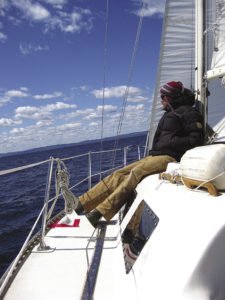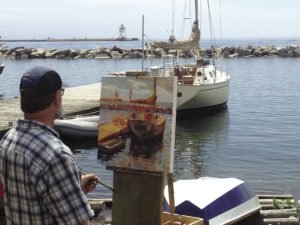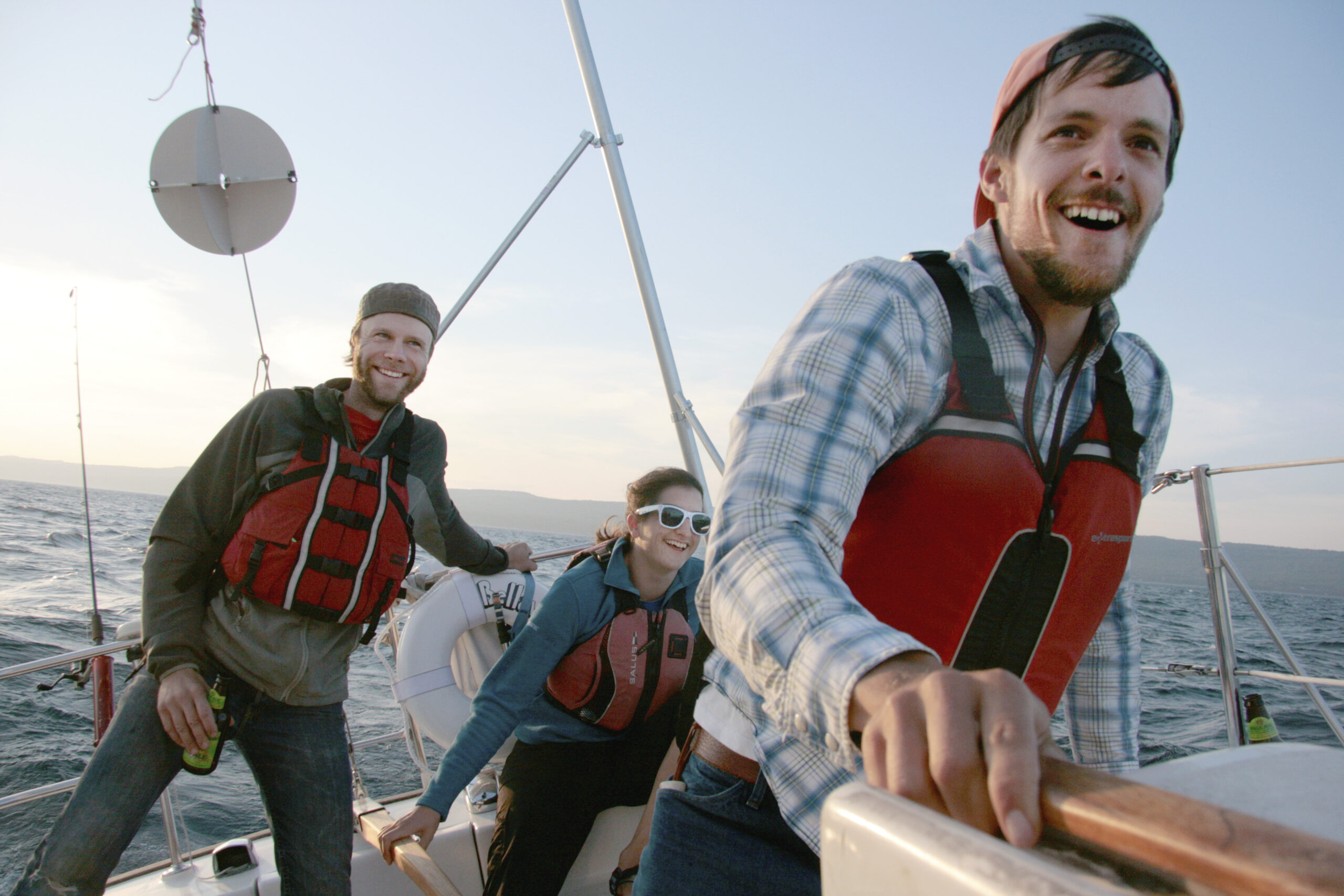Grand Marais—From the water, the North Shore is anything but welcoming; cold waters, rocky shores, inclement weather, and few safe harbors keep casual boaters away. The Coast Guard warns against it in their Coast Pilot book: “This stretch of shore should be given a berth of 1 mile because of frequent fogs and local magnetic disturbances.” But for some, that’s just an invitation to drop anchor, and Grand Marais offers one of the refuges for die-hard (or hard-headed) North Shore sailors.
I grew up on the Big Lake in Duluth, but started sailing on the small inland lakes of north-central Minnesota. Warm waters, small boats…the risks (and rocks) were fewer and consequences less dire. In college, I had the opportunity to intern and live aboard the Hjørdis—the iconic schooner of Grand Marais—and sail to the Apostle Islands and Isle Royale. I was hooked. After working in the maritime industry in Hudson River and Puget Sound, I realized that salt water was over-rated and returned to Grand Marais. Despite my better judgement, I started looking for a boat.
The search for a sailboat can be an exhaustive quest involving endless research and negotiation. Or an irrational impulse. I’ve heard of people spending years looking for the right boat with all the conveniences of home, from electrical generators to a hot water bidet. There’s typically a middleman—a yacht broker—between buyer and seller, and often boats will be professionally surveyed to determine soundness. Costs get prohibitive quickly. That process seemed painful and painfully expensive, so I went with a sweet deal I heard about word-of-mouth (albeit with financial backing—thanks Dad). Of the two philosophies—thoughtful process or rash decision-making—I planted my nautical burgee in the latter and sailed my “new” 1977 sailboat from Wisconsin to Minnesota.

Grand Marais is situated on a particularly remote and harsh stretch of Lake Superior, by boating standards. From the harbor entry, it’s 45 miles of open water to the most popular cruising destination (Apostle Islands), 50 miles from the next most popular (Isle Royale), and over 160 miles from the mystical Canadian islands of caribou (Slate Islands). The cold, bare, rocky basalt of the shoreline stands in stark comparison to the sand and relative warmth of the south shore of Lake Superior. Designated safe harbors are 30 miles apart on average; a long, soggy ride if you get caught in the ever-changing weather. If you need to repair a leak, or pull a boat out before ice crushes the hull, there’s no haul-out facility for 65 miles. Help is also scarce: The U.S. Coast Guard station North Superior is only staffed from Memorial Day to Labor Day, and they patrol from Taconite Harbor to Isle Royale to the Canadian Border, an area roughly 1,400 square miles by my Google map calculations.
Grand Marais marina manager and sailor Dave Tersteeg sums it up: “I don’t sail the North Shore. Too cold, rocky and lonesome.”
Grand Marais was so-named not because it’s a “great marsh” but instead a rare refuge of placid water on an otherwise inhospitable coast. In the centuries before Highway 61, water dominated travel on the lake and safe harbors were sanctuaries from Lake Superior storms. Unlike Duluth, it never became a large-scale industrial port, but a half-century of dredging did help create the 18-foot deep harbor, complete with concrete-clad breakwalls and a picturesque lighthouse. After the last load of pulpwood logs was hauled out, the Army Corps of Engineers allowed recreational boaters to set moorings, or the white and blue buoys attached to home-built concrete blocks with lengths of beefy chain. The City of Grand Marais now rents out a majority of those moorings on a nightly or seasonal basis. For more information on maritime history, the Cook County Historical Society recently produced a virtual harbor tour, available on YouTube, and I highly recommend a visit to their museum.
Even if you score a boat and arrange for a mooring, Lake Superior isn’t a great setting to learn how to sail. Big, cold water is a recipe for trouble on smaller boats, although a few folks have tried to make it a livelihood in Grand Marais. George Wilkes and Barb LaVigne taught for Northwind Sailing, Wilkes’ parents’ business. Although they operated for over a decade, it was an inherently fickle business model.

Even when conditions cooperated, LaVigne recalls that “buzzing in and out…it was a recipe for a fat butt.” And the rewards weren’t much better: “It was like throwing money out the window.”
So LaVigne and Wilkes opened the Angry Trout, and the rest is history.
But it’s this very remote quality that paradoxically makes the North Shore an attractive port for the cognoscenti. There are no rows of gleaming white hulls hauled out, nor the pincushion effect of hundreds of masts tied to a maze of docks; a common site on the Wisconsin side. The harbor offers some protection, space and a unique community of eccentric folks, from inspired retirees to entrepreneurs to dirtbags and everything in-between. A hull bobbing on it’s mooring has the potential to take her crew to any number of corners of Lake Superior, accessible only by water. Quiet evenings at anchor, sunsets and sunrises over Superior and the Sawtooth Mountains…you might get a few each year if you’re lucky. And I’m pretty sure it’s worth it.
The romanticism of sailing is tempered by the realities of the North Shore. If all that sounds like too much work, you’re always welcome to take a ride on the Hjørdis and leave the worry to the professional worriers: North Shore sailors.—Matt Nesheim



